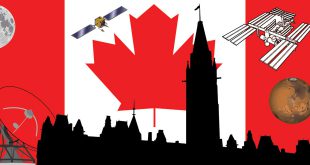COM DEV International Ltd. announced that it has won a contract to begin work on the development of an advanced satellite payload that will be used in the next generation of the global search and rescue system known as Cospas-Sarsat.
The Department of Public Works and Government Services Canada has awarded a contract to COM DEV initially worth CDN $4.7 million for the first phase of the Medium Earth Orbit Search and Rescue (MEOSAR) Project. COM DEV’s role is to design and develop a repeater that Canada plans to provide as a payload on the next generation of the Global Positioning Satellite (GPS) constellation.
The work is expected to last 15 months and it will be carried out at the Company’s Cambridge and Ottawa facilities. The contract includes a $14 million option to extend the development work to produce a fully-integrated prototype MEOSAR repeater for test and space qualification.
“We are pleased to have won another major contract for search and rescue repeaters,” said Mike Pley, CEO of COM DEV International. “This project demonstrates Canada’s continued commitment to the global search and rescue system. It is also an excellent example of how Canadian space technology can be harnessed for the benefit of all humanity.”
COM DEV began the development of its MEOSAR technology in 2008 under a cost-shared R&D project with the Canadian Space Agency. Canada’s National Search and Rescue Secretariat then provided additional R&D support through its Search and Rescue New Initiatives Fund because it was recognised that MEOSAR payload technology would help to improve the capabilities of Canada’s national search and rescue system. This new GPS MEOSAR Project will benefit from these previous R&D investments by both COM DEV and the Canadian Government.

Cospas-Sarsat was established by Canada, the United States, France, and Russia in the mid-1970s to provide a true global search and rescue system. Once in orbit 22,000 kilometres above the Earth, a MEOSAR Repeater will be able to detect signals from emergency beacons and retransmit the signals to receiver stations on Earth. The emergency messages can then be sent to appropriate authorities so that people in danger can be quickly located and rescued.
There are two types of satellites in the current system. Four low Earth orbit (LEO) satellites orbit at an altitude of 850 km, where they receive and relay the emergency beacon’s signal. LEO satellites orbit so close to the Earth, they have a small footprint – they see only a small patch of the planet at any given moment, an area with a radius of about 3000 km. To overcome constraints posed by LEO satellites, geostationary Earth orbit (GEO) satellites were added in the 1990s. These high-altitude satellites orbit directly above the equator, moving in synchrony with the Earth. Because they orbit at about 36,000 km above the Earth, GEO satellites have a huge footprint. They have, however, several downsides. GEOs are unable to “see” the poles, leaving much of the Arctic and Antarctic without service. Because GEO satellites maintain a steady position over a portion of the Earth, they don’t move relative to a signalling beacon. With no Doppler shift to provide additional information, GEOs can readily detect a distress signal but are unable to help in determining the beacon’s location.
To overcome the combined limitations of LEO and GEO satellites, MEO – medium Earth orbit – satellites are being added. They orbit between the LEO and GEO satellites.

Since becoming operational in 1982, the Cospas-Sarsat system has helped to save over
33,000 lives around the world. The MEOSAR system that will be implemented will provide faster and more accurate detection of emergency distress signals on a global basis leading to more lives being saved in the future.
Cospas-Sarsat Programme – The First Generation. Created in 2005 for the Programme’s launch in Montreal, Canada. Credit: COSPAS-SARSAT Program
COM DEV International Ltd. is a leading global provider of space hardware and services. The company has a staff of 1,300, annual revenues of $208 million, and facilities in Canada, the United Kingdom and the United States. COM DEV designs manufactures, and integrates advanced products, subsystems and microsatellites that are sold to major satellite prime contractors, government agencies and satellite operators, for use in communications, space science, remote sensing and defense applications. The company has won contracts to supply its equipment on over 900 spacecraft. COM DEV’s majority-owned subsidiary, exactEarth Ltd., provides satellite data services for global maritime surveillance.
 SpaceQ Space news and analysis.
SpaceQ Space news and analysis.


